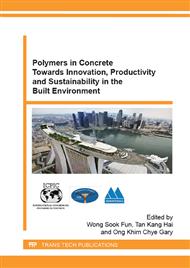p.516
p.523
p.530
p.538
p.546
p.557
p.565
p.573
p.581
Influence of Superplasticizers on the Properties of Lightweight Mortar Plaster Made with Recycled Polymers
Abstract:
The advantageous influence of two different polycarboxylate and melamine superplasticizers is studied in relation to the properties of blended mortar plaster made with recycled polymers (polyamide powder and polyurethane foam). The characteristics of the test specimens are defined and tested in both a fresh and a hardened state. The influence of the additives on the microstructure of the lightweight mortar plaster is defined through an analysis of the compatibility of the interface zone of the materials using Fast Scanning Electron Microscopy (FSEM).Our results show that the addition of additives influences the properties of the mortar plaster, enhances its mechanical properties, and increases its adherence with ceramic materials. These results confirm that superplasticizers (depending on the type and dosage) enhance both the properties of the mortar plasters produced with recycled polymers and the rheological properties of the mortars that include polyamide waste.
Info:
Periodical:
Pages:
546-553
Citation:
Online since:
November 2015
Authors:
Keywords:
Price:
Сopyright:
© 2015 Trans Tech Publications Ltd. All Rights Reserved
Share:
Citation:


